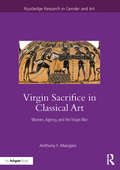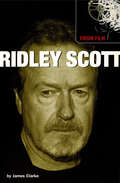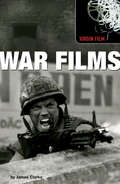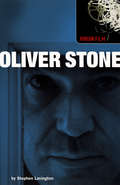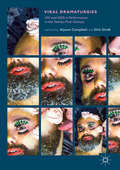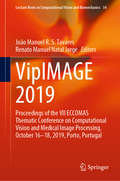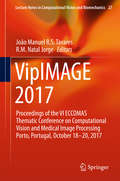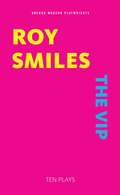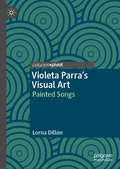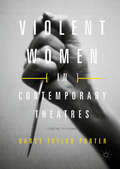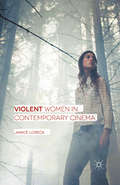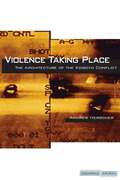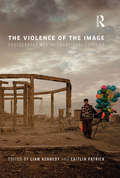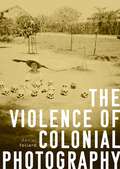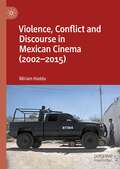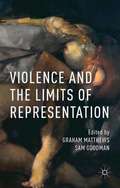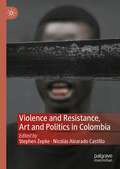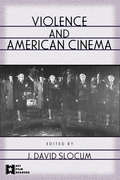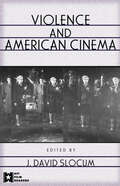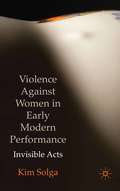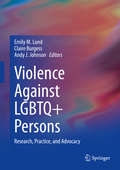- Table View
- List View
Virgin Sacrifice in Classical Art: Women, Agency, and the Trojan War (Routledge Research in Gender and Art)
by Anthony F. MangieriThe Trojan War begins and ends with the sacrifice of a virgin princess. The gruesome killing of a woman must have captivated ancient people because the myth of the sacrificial virgin resonates powerfully in the arts of ancient Greece and Rome. Most scholars agree that the Greeks and Romans did not practice human sacrifice, so why then do the myths of virgin sacrifice appear persistently in art and literature for over a millennium? Virgin Sacrifice in Classical Art: Women, Agency, and the Trojan War seeks to answer this question.This book tells the stories of the sacrificial maidens in order to help the reader discover the meanings bound up in these myths for historical people. In exploring the representations of Iphigeneia and Polyxena in Greek, Etruscan, and Roman art, this book offers a broader cultural history that reveals what people in the ancient world were seeking in these stories. The result is an interdisciplinary study that offers new interpretations on the meaning of the sacrificial virgin as a cultural and ideological construction. This is the first book-length study of virgin sacrifice in ancient art and the first to provide an interpretive framework within which to understand its imagery.
Virgin Film: Ridley Scott (Virgin Film Ser.)
by James ClarkeThis indispensable guide provides a thorough chronological examination of Ridley Scott's directorial career. All of Scott's films are included, along with information on his frequent collaborators, his thoughts on his own films, and a section on his unrealised projects. This is the essential reference guide to one of mainstream cinema's most diverse directors.
Virgin Film: War Films (Virgin Film Ser.)
by James ClarkeWar films have existed since the birth of cinema, typically gung-ho tales of macho derring-do. But war films are not always about bravado and bravery, they also detail the horrors of war, the sadness, the brotherhood of soldiers and comedy that can be found in the bleakest of situations, as well as the excitement of the battlefield. War Films explores defining movies of the genre in sections covering different wars as well as wars with other worlds.The book also offers links between the different films, historical and cinematic worth and profiles of key actors and directors. Among the films included are Saving Private Ryan, Dr Strangelove,Welcometo Sarajevo, The Dam Busters, Gallipoli, The Deer Hunter and Ran.
Virgin Film: Oliver Stone (Virgin Film Ser.)
by Stephen LavingtonThree-time Oscar winner Oliver Stone is one of the most controversial and well-known contemporary American directors. He began his professional life as a screen writer and was responsible for the scripts of Midnight Express and Scarface. As a director he made one of the all-time great Vietnam war movies, Platoon, and went on to helm such definitive cinematic works as Wall Street, Born on the Fourth of July, JFK, Natural Born Killers and, most recently, Alexander - an epic biography of the legendary Greek king starring Colin Farrell and Anthony Hopkins.This indispensable guide takes each of Stone's writing and directoial features in chronological order, discussing them within categories such as Casting, Cut Scenes, Music Conspiriacy Theory? and Controversy. It looks at the inspiration behind his work, its connection with the real world and the story behind each film's development.Whether the subject is war, politics, sport or the defining aspects of an era, Stone is an expert at polarising audience views. This is an essential reference for all fans of Oliver Stone, writer, director and one of the most influential filmmakers of the last twenty-five years.
Viral Dramaturgies: Hiv And Aids In Performance In The Twenty-first Century
by Alyson Campbell Dirk GindtHiv And Aids In Performance In The Twenty-first Century
Viral Dramaturgies: HIV and AIDS in Performance in the Twenty-First Century
by Alyson Campbell Dirk GindtThis book analyses the impact of HIV and AIDS on performance in the twenty-first century from an international perspective. It marks a necessary reaffirmation of the productive power of performance to respond to a public and political health crisis and act as a mode of resistance to cultural amnesia, discrimination and stigmatisation. It sets out a number of challenges and contexts for HIV and AIDS performance in the twenty-first century, including: the financial interests of the pharmaceutical industry; the unequal access to treatment and prevention technologies in the Global North and Global South; the problematic division between dominant (white, gay, urban, cis-male) and marginalised narratives of HIV; the tension between a damaging cultural amnesia and a potentially equally damaging partner ‘AIDS nostalgia’; the criminalisation of HIV non-disclosure; and, sustaining and sustained by all of these, the ongoing stigmatisation of people living with HIV.This collection presents work from a vast range of contexts, grouped around four main areas: women’s voices and experiences; generations, memories and temporalities; inter/national narratives; and artistic and personal reflections and interventions.
VipIMAGE 2019: Proceedings of the VII ECCOMAS Thematic Conference on Computational Vision and Medical Image Processing, October 16–18, 2019, Porto, Portugal (Lecture Notes in Computational Vision and Biomechanics #34)
by João Manuel R. S. Tavares Renato Manuel Natal JorgeThis book gathers full papers presented at the VipIMAGE 2019—VII ECCOMAS Thematic Conference on Computational Vision and Medical Image Processing—held on October 16-18, 2019, in Porto, Portugal. It discusses cutting-edge methods, findings, and applications related to 3D vision, bio- and medical imaging, computer-aided diagnosis, image enhancement, image processing and analysis, virtual reality, and also describes in detail advanced image analysis techniques, such as image segmentation and feature selection, as well as statistical and geometrical modeling. The book provides both researchers and professionals with extensive and timely insights into advanced imaging techniques for various application purposes.
VipIMAGE 2017: Proceedings of the VI ECCOMAS Thematic Conference on Computational Vision and Medical Image Processing Porto, Portugal, October 18-20, 2017 (Lecture Notes in Computational Vision and Biomechanics #27)
by João Manuel Tavares R.M. Natal JorgeThis book gathers papers presented at the VipIMAGE 2017-VI ECCOMAS Thematic Conference on Computational Vision and Medical Image Processing. It highlights invited lecturers and full papers presented at the conference, which was held in Porto, Portugal, on October 18–20, 2017. These international contributions provide comprehensive coverage on the state-of-the-art in the following fields: 3D Vision, Computational Bio-Imaging and Visualization, Computational Vision, Computer Aided Diagnosis, Surgery, Therapy and Treatment, Data Interpolation, Registration, Acquisition and Compression, Industrial Inspection, Image Enhancement, Image Processing and Analysis, Image Segmentation, Medical Imaging, Medical Rehabilitation, Physics of Medical Imaging, Shape Reconstruction, Signal Processing, Simulation and Modelling, Software Development for Image Processing and Analysis, Telemedicine Systems and their Applications, Tracking and Analysis of Movement, and Deformation and Virtual Reality.In addition, it explores a broad range of related techniques, methods and applications, including: trainable filters, bilateral filtering, statistical, geometrical and physical modelling, fuzzy morphology, region growing, grabcut, variational methods, snakes, the level set method, finite element method, wavelet transform, multi-objective optimization, scale invariant feature transform, Laws’ texture-energy measures, expectation maximization, the Markov random fields bootstrap, feature extraction and classification, support vector machines, random forests, decision trees, deep learning, and stereo vision.Given its breadth of coverage, the book offers a valuable resource for academics, researchers and professionals in Biomechanics, Biomedical Engineering, Computational Vision (image processing and analysis), Computer Sciences, Computational Mechanics, Signal Processing, Medicine and Rehabilitation.
The VIP (Oberon Modern Playwrights)
by Roy SmilesIn The VIP, Welsh film and theatre icon Richard Burton is trapped at a fog-bound Heathrow Airport in 1968 shortly after finishing filming Where Eagles Dare. He is haunted by visions of his wives Sybil and Elizabeth Taylor; his drinking companions Dylan Thomas and Peter O’Toole and his miner father. Has Burton sacrificed his considerable talent for the tarnished glory of fame, fortune and love?
Violeta Parra’s Visual Art: Painted Songs
by Lorna DillonThis book explores Violeta Parra’s visual art, focusing on her embroideries (arpilleras), paintings, papier-mâché collages and sculptures. Parra is one of Chile’s great artists and musicians, yet her visual art is relatively unknown. Her fusion of complex imagery from Chilean folk music and culture with archetypes in Western art results in a hybrid body of work. Parra’s hybridism is the story of this book, in which Dillon explores Parra’s ‘painted songs’, the ekphrastic nature of her creations and the way ideas translate from her music and poetry into her visual art. The book identifies three intellectual currents in Parra’s art: its relationship to motifs from Chilean popular and oral culture; its relationship to the work of other modern artists; and its relationship to the themes of her protest music. It argues that Parra’s commentaries on inequality and injustice have as much resonance today as they did fifty years ago. Dillon also explores the convergence between Parra’s art and the work of other modern twentieth-century artists, considering its links to Surrealism, Pop Art and the Mexican Muralism Movement. Parra exhibited in open-air art fairs, museums and cultural centres as well as in prestigious venues such as Museu de Arte Moderna do Brasil (the Museum of Modern Art in Brazil) and the Musée des Arts Décoratifs (Museum of Decorative Arts) in Paris. This book reflects on Parra’s socially-engaged work as it was expressed through her exhibitions in these centres as well as in through own cultural centre La carpa de la reina.
Violent Women in Contemporary Theatres
by Nancy Taylor PorterThis book brings together the fields of theatre, gender studies, and psychology/sociology in order to explore the relationships between what happens when women engage in violence, how the events and their reception intercept with cultural understandings of gender, how plays thoughtfully depict this topic, and how their productions impact audiences. Truthful portrayals force consideration of both the startling reality of women's violence -- not how it's been sensationalized or demonized or sexualized, but how it is -- and what parameters, what possibilities, should exist for its enactment in life and live theatre. These women appear in a wide array of contexts: they are mothers, daughters, lovers, streetfighters, boxers, soldiers, and dominatrixes. Who they are and why they choose to use violence varies dramatically. They stage resistance and challenge normative expectations for women. This fascinating and balanced study will appeal to anyone interested in gender/feminism issues and theatre.
Violent Women in Contemporary Theatres: Staging Resistance (PDF)
by Nancy Taylor PorterThis book brings together the fields of theatre, gender studies, and psychology/sociology in order to explore the relationships between what happens when women engage in violence, how the events and their reception intercept with cultural understandings of gender, how plays thoughtfully depict this topic, and how their productions impact audiences. Truthful portrayals force consideration of both the startling reality of women's violence — not how it's been sensationalized or demonized or sexualized, but how it is — and what parameters, what possibilities, should exist for its enactment in life and live theatre. These women appear in a wide array of contexts: they are mothers, daughters, lovers, streetfighters, boxers, soldiers, and dominatrixes. Who they are and why they choose to use violence varies dramatically. They stage resistance and challenge normative expectations for women. This fascinating and balanced study will appeal to anyone interested in gender/feminism issues and theatre.
Violent Women in Contemporary Cinema
by Janice LoreckViolent women in cinema pose an exciting challenge to spectators, overturning ideas of 'typical' feminine subjectivity. This book explores the representation of homicidal women in contemporary art and independent cinema. Examining narrative, style and spectatorship, Loreck investigates the power of art cinema to depict transgressive femininity.
Violence Taking Place: The Architecture of the Kosovo Conflict (Cultural Memory in the Present #440)
by Andrew HerscherWhile the construction of architecture has a place in architectural discourse, its destruction, generally seen as incompatible with the very idea of "culture," has been neglected in theoretical and historical discussion. Responding to this neglect, Herscher examines the case of the former Yugoslavia and in particular, Kosovo, where targeting architecture has been a prominent dimension of political violence. Rather than interpreting violence against architecture as a mere representation of "deeper" social, political, or ideological dynamics, Herscher reveals it to be a form of cultural production, irreducible to its contexts and formative of the identities and agencies that seemingly bear on it as causes. Focusing on the particular sites where violence is inflicted and where its subjects and objects are articulated, the book traces the intersection of violence and architecture from socialist modernization, through ethnic and nationalist conflict, to postwar reconstruction.
The Violence of the Image: Photography and International Conflict (International Library Of Visual Culture Ser.)
by Liam KennedyPhotography has visualized international relations and conflicts from the midnineteenth century onwards and continues to be an important medium in framing the worlds of distant, suffering others. Although photojournalism has been challenged in recent decades, claims that it is dead are premature. The Violence of the Image examines the roles of image producers and the functions of photographic imagery in the documentation of wars, violent conflicts and human rights issues; tackling controversial ideas such as 'witnessing', the making of appeals based on displays of human suffering and the much-cited concept of 'compassion fatigue'. In the twenty-first century, the advent of digital photography, camera phones and socialmedia platforms has altered the relationship between photographers, the medium and the audience- as well as contributing to an ongoing blurring of the boundaries between news and entertainment and professional and amateur journalism. The Violence of the Image explores how new vernacular and artistic modes of photographic production articulate international friction.This innovative, timely book makes a major contribution to discussions about the power of the image in conflict.
The Violence of the Image: Photography and International Conflict
by Liam Kennedy Caitlin PatrickPhotography has visualized international relations and conflicts from the midnineteenth century onwards and continues to be an important medium in framing the worlds of distant, suffering others. Although photojournalism has been challenged in recent decades, claims that it is dead are premature. The Violence of the Image examines the roles of image producers and the functions of photographic imagery in the documentation of wars, violent conflicts and human rights issues; tackling controversial ideas such as 'witnessing', the making of appeals based on displays of human suffering and the much-cited concept of 'compassion fatigue'. In the twenty-first century, the advent of digital photography, camera phones and socialmedia platforms has altered the relationship between photographers, the medium and the audience- as well as contributing to an ongoing blurring of the boundaries between news and entertainment and professional and amateur journalism. The Violence of the Image explores how new vernacular and artistic modes of photographic production articulate international friction.This innovative, timely book makes a major contribution to discussions about the power of the image in conflict.
The violence of colonial photography
by Daniel FoliardThe late nineteenth century saw a rapid increase in colonial conflicts throughout the French and British empires. It was also the period in which the camera began to be widely available. Colonial authorities were quick to recognise the power of this new technology, which they used to humiliate defeated opponents and to project an image of supremacy across the world.Drawing on a wealth of visual materials, from soldiers’ personal albums to the collections of press agencies and government archives, this book offers a new account of how conflict photography developed in the decades leading up to the First World War. It explores the various ways in which the camera was used to impose order on subject populations in Africa and Asia and to generate propaganda for the public in Europe, where a visual economy of violence was rapidly taking shape. At the same time, it reveals how photographs could escape the intentions of their creators, offering a means for colonial subjects to push back against oppression.
The violence of colonial photography
by Daniel FoliardThe late nineteenth century saw a rapid increase in colonial conflicts throughout the French and British empires. It was also the period in which the camera began to be widely available. Colonial authorities were quick to recognise the power of this new technology, which they used to humiliate defeated opponents and to project an image of supremacy across the world.Drawing on a wealth of visual materials, from soldiers’ personal albums to the collections of press agencies and government archives, this book offers a new account of how conflict photography developed in the decades leading up to the First World War. It explores the various ways in which the camera was used to impose order on subject populations in Africa and Asia and to generate propaganda for the public in Europe, where a visual economy of violence was rapidly taking shape. At the same time, it reveals how photographs could escape the intentions of their creators, offering a means for colonial subjects to push back against oppression.
Violence, Conflict and Discourse in Mexican Cinema (2002-2015)
by Miriam HadduThe last two decades have seen dramatic changes to Mexico’s socio-political landscape. A former president fleeing into exile, political assassinations, a rebellion in Chiapas, and the eruption of the so-called war on drugs provide key examples of critical events shaping the nation. This book examines Mexican cinema’s representations of, and responses to, these socio-political moments. Beginning with the definitive year 1994, which saw the Ejército Zapatista de Liberación Nacional (EZLN) declare war on the Mexican government, the early chapters in this book discuss the outcome of these episodes in subsequent years and how they find screen representation. The study then moves on to provide close readings of key filmic texts as reflections of the so-called narco-war and its effects on Mexican society. Focusing on both fiction and documentary filmmaking, this book explores notions of violence, victimhood, and the complex processing of grief in the context of enforced disappearances and the narco-conflict. In addition to examining films made in Mexico, this investigation incorporates the work of three of the nation’s most celebrated transnational directors: Guillermo del Toro, Alejandro González Iñárritu and Alfonso Cuarón. By examining their work on European soil as a comparative exercise, the analyses offer an understanding of the imprints left by warfare and trauma upon the collective and individual psyche, seen from a universal viewpoint. Using rigorous theoretical frameworks and succinct filmic analyses, this book will be essential reading for those interested in Mexican and Latin American film, as well as those working in the fields of Cultural, Screen, and Trauma Studies.
Violence and the Limits of Representation
by Graham MatthewsViolence and the Limits of Representation explores the representation of violence in literature, film, drama, music and art in order to demonstrate the ways in which the work done by researchers in the Arts and Humanities can offer fresh perspectives on current social and political issues.
Violence and Resistance, Art and Politics in Colombia
by Stephen Zepke Nicolás Alvarado CastilloThis book explores the historical and contemporary connections between art and politics in Colombia. These relations are unique because of the ways in which they are saturated by violence, as the country has passed through conquest, struggles for Independence, fighting between political factions, civil war, paramilitaries, narco-traffickers and state violence. This seemingly unending stream of violence gives art in Colombia one of its main themes. The lavishly illustrated essays, written by Colombian authors, examine Colombian visual arts, music, theatre, literature, cinema, indigenous arts, popular culture, militant publications and recent protest movements, analysing them with tools drawn from contemporary philosophy and theory. Approaches include decolonisation theory, cosmopolitics, anthropology after the ontological turn, Colombian philosophy, feminism, and French theory. The essays all offer powerful understandings of how art has not only been complicit in perpetuating political violence in Colombia, but also how it has been a vital form of analysis and resistance.
Violence and American Cinema (AFI Film Readers)
by J. David SlocumFirst Published in 2001. Routledge is an imprint of Taylor & Francis, an informa company.
Violence and American Cinema: Violence And American Cinema (AFI Film Readers)
by J. David SlocumFirst Published in 2001. Routledge is an imprint of Taylor & Francis, an informa company.
Violence Against Women in Early Modern Performance: Invisible Acts
by Kim SolgaExamining some of the most iconic texts in English theatre history, including Titus Andronicus and The Changeling, this book, now in paperback with a new Preface, reveals the pernicious erasure of rape and violence against women in the early modern era and the politics and ethics of rehearsing these negotiations on the 20th and 21st century stages.
Violence Against LGBTQ+ Persons: Research, Practice, and Advocacy
by Emily M. Lund Claire Burgess Andy J. JohnsonAs violence against LGBTQ+ persons continues to be a pervasive and serious problem, this book aims to inform mental health providers about the unique needs of LGBTQ+ survivors of interpersonal and structural violence. Individual chapters analyze unique aspects of violence against specific subpopulations of LGBTQ+ persons in order to avoid ineffective and sometimes simplistic one-size-fits-all treatment strategies. Among the topics covered: Macro Level Advocacy for Mental Health Professionals: Promoting Social Justice for LGBTQ+ Survivors of Interpersonal Violence Intimate Partner Violence in Women’s Same-Sex Relationships Violence Against Asexual PersonsInvisibility and Trauma in the Intersex CommunitySexual and Gender Minority Refugees and Asylum Seekers: An Arduous JourneySexual and Gender Minority Marginalization in Military ContextsNavigating Potentially Traumatic Conservative Religious Environments as a Sexual/Gender Minority Violence Against LGBTQ+ Persons prepares mental health professionals for addressing internalized forms of prejudice and oppression that exacerbate the trauma of the survivor, in order to facilitate healing, empowerment, healthy relationships, and resilience at the intersection of sexual orientation, gender identity, gender expression, and diverse social locations. This is a valuable reference for psychologists, social workers, counselors, nurses, mental health professionals, and graduate students, regardless of whether they are preparing for general practice, treatment of LGBTQ+ clients, or treatment of survivors and perpetrators of various forms of violence.
